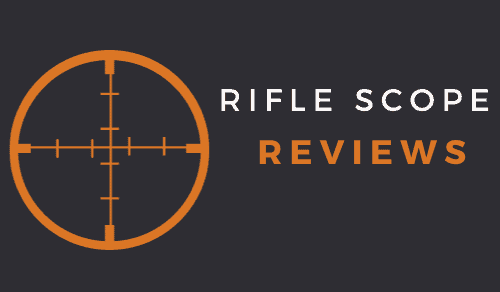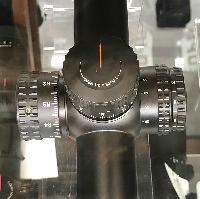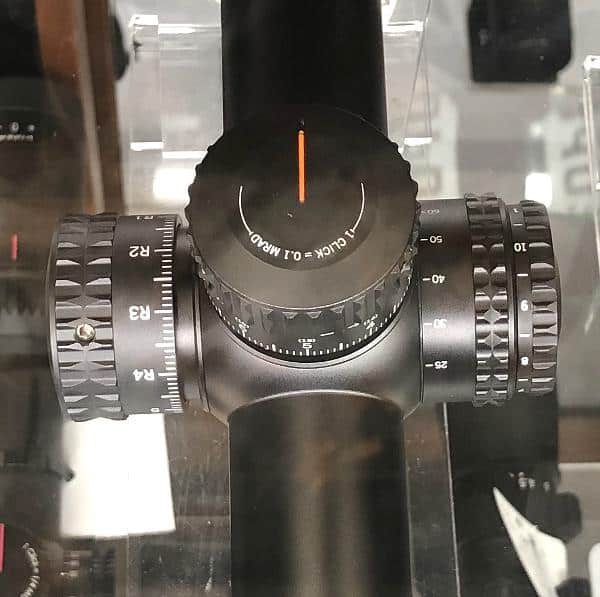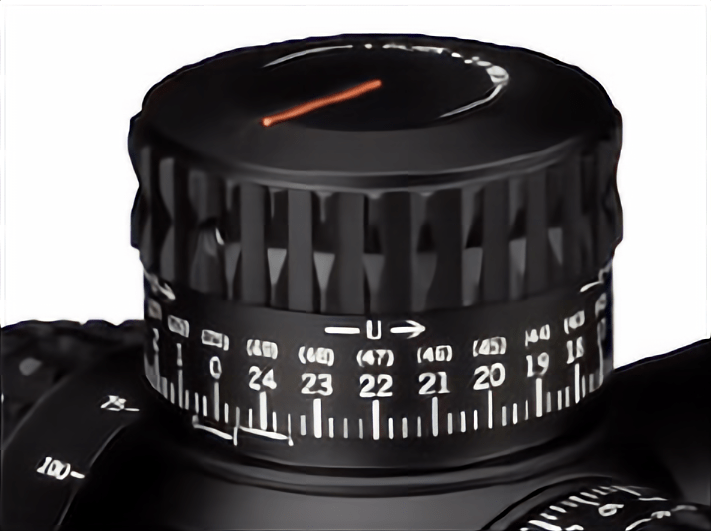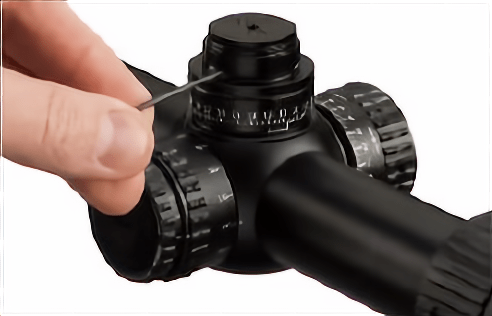As an Amazon Associate I earn from qualifying purchases. Amazon and the Amazon logo are trademarks of Amazon.com, Inc, or its affiliates.
Vortex Optics is a huge seller at my day job, so I spend a significant amount of time showing, demoing, or discussing the different Vortex scope lines. One question that I’ve been asked repeatedly about the Vortex line is this one: which Vortex scopes have a zero stop feature? Given the interest in this question, coupled with the fact that I’ve previously answered the question via email more than once, I thought it might make sense to address the answer on this blog.
What is Zero Stop on a Riflescope?
When shooting longer ranges, a shooter may have to turn the elevation scope turret in order to move the scope elevation up for a longer shot. Zero stop is a feature found on some riflescopes that prevent the shooter from dialing the elevation turret on the scope back down past a specific zero point.
Having a zero stop function on a scope means that the shooter can easily dial the elevation turret back down to a preset zero point. If you aren’t shooting at longer ranges, it may not be a feature that you use, but, if you’re dialing a scope up to shoot at 1000 yards, it can be invaluable.
Vortex Offers Four Different Zero Stop Configurations
Another point to make in trying to answer this question about zero stops is that Vortex does not offer a single zero stop configuration available on all Vortex scopes.
They offer four different zero-stop configurations, and they are not available on every Vortex riflescope.
Those configurations are:
- Vortex CRS Zero Stop
- Vortex RevStop Zero System
- Vortex RZR Zero Stop
- Vortex L-Tec Zero Stop
Let’s look at each of these zero stop options in more detail:
Vortex CRS Zero Stop
The CRS Zero Stop is a shim-based system that is not a “true” mechanical stop as the elevation turret can be dialed down past the original zero point (which generally can’t be done on a mechanical zero stop). However, with the CRS system, the turret can only be dialed down a few clicks past the original point, so it may require a slight manual adjustment to return to the original zero point.
I’ve tested the CRS zero stop (with CRS being an acronym for Custom Rotation Stop), and it works reasonably well. The shims are not difficult to install or configure, and the zero stop works as advertised. Here are the two issues that I most commonly see with this set-up:
- The idea that all the included shims have to be used – Although Vortex addresses this in the CRS manual, I still see situations at my day job where customers incorrectly believe that they need to use every shim that comes with the scope during the configuration process. Depending on the original zero distance, you may not have to use every shim.
- Shim installation issues – The shims on this configuration have to be inserted with the open end of the shim alternating between each shim. If the shims are all installed with the open end of each shim facing the same direction, the zero stop doesn’t function correctly.
As you read on, you may notice that the CRS zero stop set-up is available on the mid-priced, long-range Vortex scopes, while the RZR and L-Tec Zero Stop systems discussed below are found on the more expensive models.
The CRS Zero Stop system is available on the following Vortex scope lines:
- Vortex Viper HS LR series
- Vortex Viper HST series
Vortex RevStop Zero System
The RevStop Zero set-up is one of Vortex’s newer Zero Stop configurations and is a bit of a cross between a shim-based zero stop and a mechanical zero stop.
However, like the CRS Zero Stop set-up, the RevStop configuration is also not an actual mechanical zero stop as it will allow the shooter to return to zero slightly past the original zero distance.
The RevStop Zero system is straightforward to configure (much easier than the CRS Zero Stop, in my opinion) and works well.
The idea behind the ability to turn the elevation turret back down past the original zero stop point centers on the possibility that you might have to take a shot at a closer target than the initial zero distance.
Given a choice between a CRS stop and the RevStop Zero stop, I prefer the RevStop. I’m guessing that Vortex will eventually phase out the CRS set-up in favor of the RevStop design.
To date, I haven’t encountered any situations at my day job with customers configuring the RevStop set-up.
The RevStop Zero system is available on the following Vortex scope lines:
- Vortex Strike Eagle (only the 5-25×56 FFP model currently)
- Vortex Razor HD LHT series
Vortex RZR Zero Stop
The Vortex RZR Zero Stop system is different from the shim-based CRS Zero Stop set-up. The RZR system is an actual mechanical zero stop where the elevation turret cannot be adjusted past the configured zero point.
I’ve seen several references online saying that the RZR system is named after the Vortex Razor series of scopes because it was initially designed as a zero-stop system for the Razor scopes. While that may be true, the RZR is an acronym for Rapid Zero Return.
I’ve tested out the RZR zero-stop system, and it works very well. Although I never had any issues with it, I have had customers from my day job say that it was a bit tricky to configure the RZR set-up.
The most common set-up issue I see configuring the RZR set-up is not tightening the three-set screws on the internal turret all the way down. This issue causes the inner turret not to lock correctly, so it will not stay in place during the configuration process.
The RZR Zero Stop set-up is available on the following Vortex series of riflescopes:
- Vortex PST Gen II series
- Vortex Razor HD series
Vortex L-Tec Zero Stop
The L-Tec Zero Stop system is another proprietary zero stop design found on several of Vortex’s higher-end scope models. The L-Tec platform is a mechanical zero-stop system that is easy to configure and use.
This zero stop system is integrated into the L-Tec turret system and is one of the most straightforward zero stop/turret systems that I’ve tested.
Out of all the Vortex zero-stop systems they currently offer, the L-Tec is my favorite for ease of configuration and use. However, this zero-stop setup is only found on the upper-level Vortex scopes so that ease of use and setup comes with a higher price tag.
The Vortex L-Tec Zero Stop system is available on the following Vortex scope lines:
- Vortex Razer HD Gen II series
- Vortex Razor HD AMG series
What’s the “Best” Vortex Zero Stop System?
“Best” is always open for debate, but here are my thoughts on each system:
- The L-Tec system is the most technically advanced and the easiest to configure. However, it’s only found on Vortex’s top two series, so it has a somewhat limited availability. This one is my favorite of all the existing Vortex zero-stop options.
- The RevStop system is kind of a hybrid set-up with design elements from both a shim-based system and a traditional mechanical zero stop configuration. I like the simplicity of set-up and found it to be my second favorite option.
- The RZR system is good and works well but can be tricky to set up if you don’t take the time to go through the manual and/or video instructions. I’d say it’s my 3rd favorite option in the Vortex zero-stop family.
- The CRS system is probably my least favorite, and that’s more tied to the design concept versus the actual application. To me, this approach to shims is a bit dated, and I’d be surprised if Vortex didn’t phase it out in favor of the RevStop system before long.
FAQS
Here are some frequently asked questions that I see regarding the different Vortex zero stop options:
How do you set the zero stop on a Vortex Viper PST Gen 2?
While I could write up something about setting the zero stop on the RZR zero stop that comes on the PST Gen II series, Vortex has put together an excellent how-to video that does a far better job explaining the process, and I’ve linked to it below:
What zero stop system comes on the Vortex Diamondback Tactical scopes?
Unfortunately, at the time of this writing, Vortex was not offering a zero-stop option on any of the Diamondback Tactical series of scopes.
Vortex does not offer a zero-stop option on the standard Diamondback series of scopes either.
Where can I get some more of the Vortex Viper zero stop shims?
Vortex previously offered the CRS Zero Stop shims for sale in a pack of 10, but they have stopped selling that package (which is another reason I suspect that the CRS system is slowly being phased out).
Because Vortex has stopped offering the CRS shim package, they are equally hard to locate outside of Vortex.
At this point, your best bet is to call Vortex and ask to either purchase some or have some sent to you.
Can you talk about setting the zero stop on a Vortex Razor Gen 2?
The answer to that question will depend on the specific Vortex Razor Gen II model being focused on within the question.
If you mean the Razor Gen II HD, then we’re talking about the L-Tec Zero Stop System. If you mean the original Razor Gen II scopes, then you’re asking about the RZR zero stop set-up.
Since I’m not exactly sure which Razor model or version you are asking about, coupled with the fact that Vortex offers excellent how-to videos about both topics, here are links that will answer the question:
How to set the Vortex L-Tec Zero Stop system
I’ve been working in the firearms and sporting optics industry for over 20 years, with a personal and professional interest in all things related to rifle scopes, Through a combination of work experience, formal training, and personal experiences, I have extensive experience mounting, testing, and evaluating different rifle scope models across most major optical brands.
